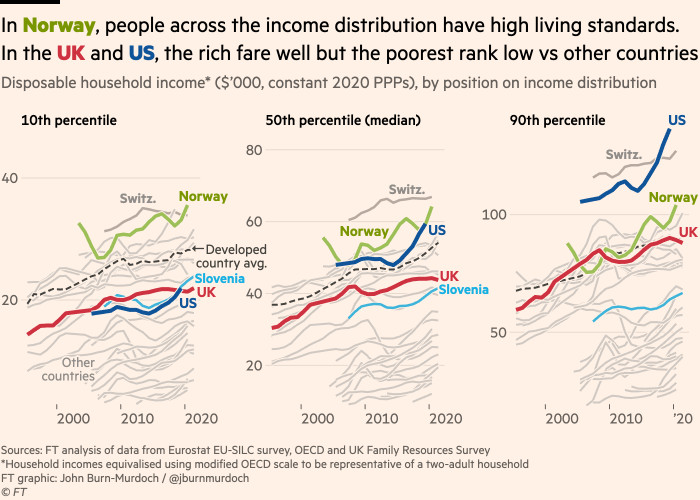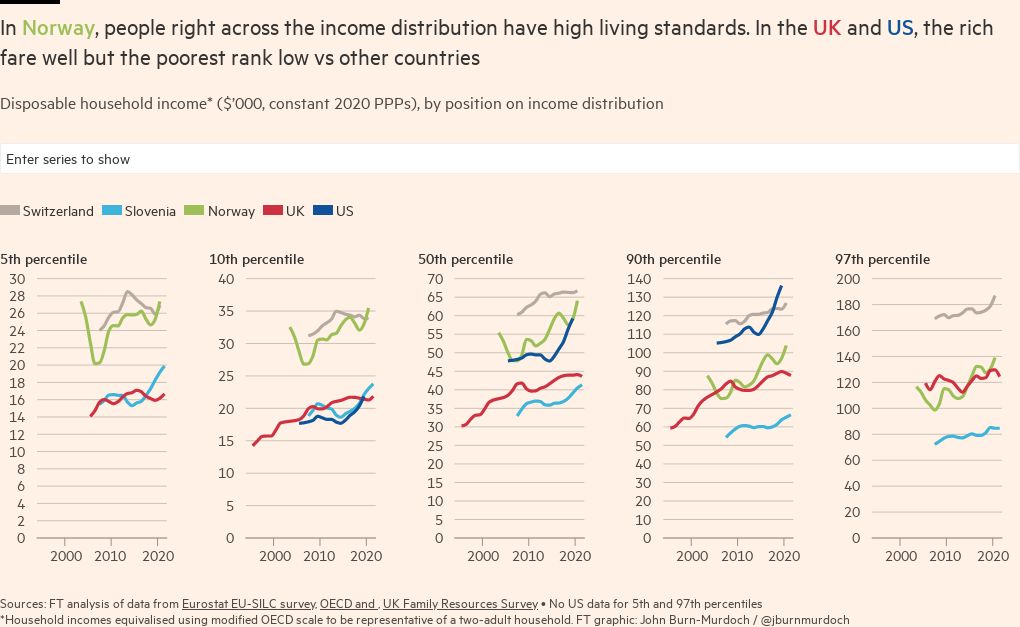Britain and the US are poor societies with some very rich people


Roula Khalaf, Editor of the FT, selects her favourite stories in this weekly newsletter.
Where would you rather live? A society where the rich are extraordinarily rich and the poor are very poor, or one where the rich are merely very well off but even those on the lowest incomes also enjoy a decent standard of living?
For all but the most ardent free-market libertarians, the answer would be the latter. Research has consistently shown that while most people express a desire for some distance between top and bottom, they would rather live in considerably more equal societies than they do at present. Many would even opt for the more egalitarian society if the overall pie was smaller than in a less equal one.
On this basis, it follows that one good way to evaluate which countries are better places to live than others is to ask: is life good for everyone there, or is it only good for rich people?
To find the answer, we can look at how people at different points on the income distribution compare to their peers elsewhere. If you’re a proud Brit or American, you may want to look away now.
Starting at the top of the ladder, Britons enjoy very high living standards by virtually any benchmark. Last year the top-earning 3 per cent of UK households each took home about £84,000 after tax, equivalent to $125,000 after adjusting for price differences between countries. This puts Britain’s highest earners narrowly behind the wealthiest Germans and Norwegians and comfortably among the global elite.
So what happens when we move down the rungs? For Norway, it’s a consistently rosy picture. The top 10 per cent rank second for living standards among the top deciles in all countries; the median Norwegian household ranks second among all national averages, and all the way down at the other end, Norway’s poorest 5 per cent are the most prosperous bottom 5 per cent in the world. Norway is a good place to live, whether you are rich or poor.
Britain is a different story. While the top earners rank fifth, the average household ranks 12th and the poorest 5 per cent rank 15th. Far from simply losing touch with their western European peers, last year the lowest-earning bracket of British households had a standard of living that was 20 per cent weaker than their counterparts in Slovenia.

It’s a similar story in the middle. In 2007, the average UK household was 8 per cent worse off than its peers in north-western Europe, but the deficit has since ballooned to a record 20 per cent. On present trends, the average Slovenian household will be better off than its British counterpart by 2024, and the average Polish family will move ahead before the end of the decade. A country in desperate need of migrant labour may soon have to ask new arrivals to take a pay cut.
Across the Atlantic it’s the same story, only more so. The rich in the US are exceptionally rich — the top 10 per cent have the highest top-decile disposable incomes in the world, 50 per cent above their British counterparts. But the bottom decile struggle by with a standard of living that is worse than the poorest in 14 European countries including Slovenia.
To be clear, the US data show that both broad-based growth and the equal distribution of its proceeds matter for wellbeing. Five years of healthy pre-pandemic growth in US living standards across the distribution lifted all boats, a trend that was conspicuously absent in the UK.
But redistributing the gains more evenly would have a far more transformative impact on quality of life for millions. The growth spurt boosted incomes of the bottom decile of US households by roughly an extra 10 per cent. But transpose Norway’s inequality gradient on to the US, and the poorest decile of Americans would be a further 40 per cent better off while the top decile would remain richer than the top of almost every other country on the planet.
Our leaders are of course right to target economic growth, but to wave away concerns about the distribution of a decent standard of living — which is what income inequality essentially measures — is to be uninterested in the lives of millions. Until those gradients are made less steep, the UK and US will remain poor societies with pockets of rich people.
Use the interactive version of the chart below to compare other countries:
john.burn-murdoch@ft.com
@jburnmurdoch
Letter in response to this article:
Analysis of poverty understates the issues / From Steve New, Fellow, Hertford College Associate Professor of Operations Management, Saïd Business School, University of Oxford, UK

Comments